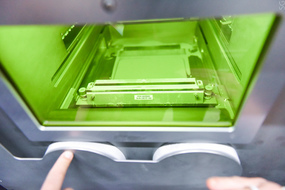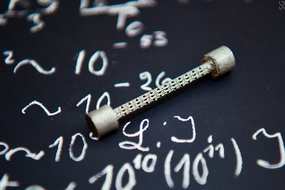NUST MISIS engineers have proposed an innovative strategy of an additive printing of metal parts in a complex shape: the discovered ability to print cellular structures in their basis will reduce the weight of these metal parts and give them special properties. The new additive printing will cut the metal parts’ weight in half, while allowing them to maintain their strength. This is extraordinarily promising for engineering vehicles and space crafts.
Additive technologies are actively entering into modern industries, although there are still many unknown aspects for designers regarding the material’s production and structure. For example, regular mesh structures in an engine or body parts of a car or rocket can carry loads similar to cast parts, while weighing half as much. As a result of using this technology and decreasing the weight, you’ll get a reduction of fuel consumption, harmful emissions into the atmosphere, and the amount of metal needed to produce the parts. The pressing question then, is how to obtain these cellular structures.
“Engineers from the NUST MISIS Laboratory for Hybrid Additive Technologies have presented the results of their studies of macro-, microstructure and mechanical properties for tension and compression of steel cellular structures of various configurations, models of which were prepared using specialized Russian software for topological optimization and manufactured using selective laser melting technology on a 3D Russian installation. We have shown that the level of mechanical properties depends on the cells’ configuration, the size of their elements and the volume of the voids. At the same time, we have calculated the type and configuration of cellular structures at which the maximum level of [desired] properties is achieved”, said Andrey Travyanov, Candidate of Technical Sciences, head of the team and head of the NUST MISIS College of Environmentally Sound Technologies & Engineering.
For the first time, machine-builders have managed to obtain accurate data on the types of cellular structures corresponding to a specific engineering task, allowing a part with the desired strength and weight to be made using a certain type of cell. Additive engineers have also mastered the part’s production on a 3D printer using selective laser melting.
The use of what is typically referred to as bionic design — computer topological optimization — is one of the most promising approaches of modern engineering. This is a special approach to design that allows engineers to find the best distribution of the material in a given area for a given load and operating conditions.
Simply put, the abstract part is a massive three-dimensional monolith and a significant part of the material even though it doesn’t carry any functional load, which means it contains excess metal. Usually, only about ten attachment points carry the load on these parts.
The shape of the part is significantly complicated as a result of optimization — in this case, metal honeycomb-shaped cellular structures are obtained. It is simply impossible to make them using traditional methods such as casting since they are too complex. So, in this case, the only way to manufacture them is the use of additive technologies of layer printing metals, in particular, selective laser melting. The method is characterized by its low costs and its ability to create a product of almost any shape.
The samples of cellular structures obtained at NUST MISIS have already passed lab tests and will soon be delivered to designers at the appropriate companies.






